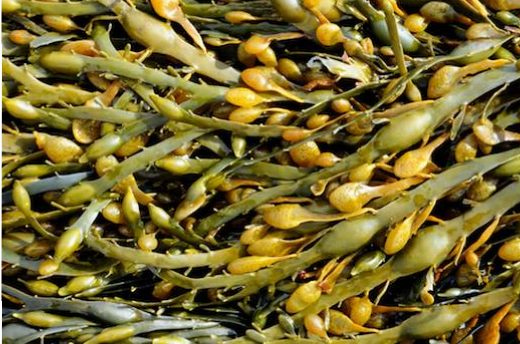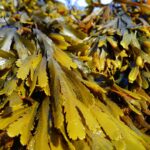We use cookies to make your experience better. To comply with the new e-Privacy directive, we need to ask for your consent to set the cookies. Learn more.
What is a Biostimulant?

A plant biostimulant is any substance or microorganism applied to plants with the aim to enhance nutrition efficiency, abiotic stress tolerance (abiotic factors are the non-living parts of an environment and include sunlight, temperature, weather and altitude) and/or crop quality traits. Biostimulants promote plant growth without being a fertilizer. Biostimulants are available in many formulations and with varying ingredients. The most popular ingredients are seaweed extracts, beneficial bacteria, and beneficial fungi and humic substances (humic and fulvic acids).
Seaweed (Ascophyllum nodosum)
Seaweed is an important soil improver rich in minerals, trace elements and amino acids. It is a slow release soil conditioner and regular dressings will stimulate microbial activity acting to improve soil structure and fertility. Promotes healthy growth and increased yield in fruit and vegetables, longer lasting, richer coloured flowers.
Seaweed extracts act as biostimulants mainly due to the presence of plant hormones. Main phytohormones identified in seaweed extracts are: auxins, cytokinins, gibberelins, abscisic acid and ethylene.
- Auxins are responsible for the growth of plant tissues, cell division, plant movements and plant aging.
- Cytokinins are involved in cell division regulation affecting plant growth and rest period. They also inhibit the aging of plant tissues and play crucial role in transport of nutrients.
- Gibberellins help with seed germination, breaking bud dormancy and fruit development.
- Abscisic acid and ethylene help with stress factors and inhibition of cell growth.
Mycorrhizae
Mycorrhizae are actually a fungus. They exist as very tiny, microscopic threads which are all interconnected into a net-like web which measures hundreds or thousands of miles - all packed into a tiny area around the plant. Fungal threads can grow many metres from the roots and are microscopically thin, thus they end up in places where roots can never reach. This greatly extended root system of the plants facilitates much easier absorption of water and nutrients. The association between a green plant and Mycorrhizae is a symbiotic association The plant makes organic molecules such as sugars by photosynthesis and supplies them to the fungus, and the fungus supplies to the plant water and mineral nutrients, such as phosphorus, taken from the soil.
Advantages of Mycorhizae
- The absorption capacity of the roots increases by as much as 700%. It is much easier for the plants to absorb nutrients and water. The beneficial fungi and soil bacteria occupy the space around the roots so that pathogens are kept away.
- Many scientific studies show that the presence of useful mycorrhizal fungi noticeably improves plant health.
- Plants can also make do with less fertiliser. In addition, organic fertilisers are utilised better. The mycorrhizae thereby support plant resistance; they improve growth and the crop produces more fruit of better quality.
- Plants with mycorrhizae are more resistant to drought, severe temperature variations, pH changes, toxic metals and soil compacting. Mycorrhizae also ensure better soil structure due to their contribution to forming ‘soil aggregates’
AMN BonaVita
An organic plant and soil additive containing proteins, amino acids and vitamins which feed and promote soil micro-organisms. After more than a decade of studying the substances found in the supremely fertile primeval forest soils of the world, BonaVita was formulated to introduce a range of the nutrients found there into cultivated soils.
- Contains proteins, amino acids and vitamins which feed the plants and soil micro-organisms including Mycorrhiza fungi.
- The improved soil biology can reduce fertilizer requirements by 30%.
- Can be sprayed or added to irrigation systems.
- Can be used on sensitive plants.
- Composed of plant extracts and organic residues from food production.
Humisol
A liquid bio-humus created from worm casts and enriched with their microflora. Includes humates, fulvic acids, phytohormones and highly available trace elements which work to promote plant health and release nutrients from the soil. Humus is the dark organic matter that forms in soils when dead plant and animal matter is fully decomposed. The compounds found in humus, mainly humates and fulvic acids, have important properties for soil and plant health such as stabilising nitrogen, promoting mycorrhizal fungi and freeing locked up Phosphorus.
- Humisol is produced from Biohumus which is the controlled creation of humus using red worms to treat cow dung.
- Contains humates, fulvic acids, amino-acids, vitamins, phytohormones and a variety of micro organisms including spore bacteria, lactobacteria and bifidobacteria.
- These elements confer increased resistance of bacterial and fungal diseases to plants. This resistance is also helped by the presence of highly available trace elements like Copper and Zinc.
- Helps with the availability of N, P and trace elements in the soil.
- Stimulates plant enzymes and promotes root development.
- Increased yield and qualitative characteristics in trials.
Fulvic
Mobiliser HF is a natural soluble chelating agent. It contains fulvic (19%) and humic (1%) substances which act as a biostimulant to enhance root and shoot development as well as the nutrient uptake of plants. It is derived from Dutch groundwater which is extracted from a depth of 300m. In the process of making the water potable, fulvic and humic substances are removed using a non chemical and foodgrade process.
- Makes minerals that are locked up in the soil available to plants by chelation.
- Can be mixed with foliar feeds to increase nutrient uptake.
- Stimulates soil life.
- Stimulates enzymatic processes within plants which increases photosynthesis and promotes more tolerance to abiotic stress.
Pireco Plant Strengtheners
Pireco makes a range of plant strengtheners based on carefully selected herbs. Each is specifically targeted to a type of plant to make them more resilient to abiotic stresses. Pireco products are rich in main and micro-elements, which will restore the natural balance and result in a strong and vital crop. These products support the natural recovery ability and have a wholesome, nourishing and plant strengthening effect when the soil and the plants are influenced from the outside.
- Stimuter - Its root-stimulating and plant-enhancing ingredients allow the plant to develop an increased resistance and vitality. It is especially useful when plant stress is expected, due to transplanting, weather conditions etc.
- Mucofol - Mucofol can be helpful with the control of fungal and mould diseases on woody plants - Leaf Spot Disease, Powdery mildew, Downy mildew, Black Spot, Rust and Scab. The ingredients have an indirect effect on pests and diseases. Foliar fungi and moulds will be inhibited in their development. The crops will be stimulated to develop their own defence system. As a result the plants will show a healthy growth.
- Herfosec - Herfosec can be used on herbaceous plants. It strengthens the plants and makes them less prone to attack from harmful insects and their larvae, such as: Aphids, Whitefly, Caterpillars, Diamond Back Moth, Vine weevil, Spider Mites, Gall Midge, LeafMiner, Thrips, Scale insects, Pear's Psylla, Mealybugs, Strawberry blossom weevil, Lily Beetle
- Herfomyc - It can be used on herbaceous crops where there has been a problem with moulds or fungi in the past, such as: Blight (Phytophtera), Leaf Spot Disease, Powdery mildew, Downy mildew, Black Spot, Rust, Dollarspot, Snowmold, Red Board. Due to the root stimulating and nutritional ingredients roots, leaves and soil develop an increased resistance.
- Folisec - Folisec can be used on woody plants. It strengthens the plants and makes them less prone to attack from harmful insects and their larvae, such as: Whitefly, Caterpillars, Pear's Psylla, Spider Mites, Gall Midge, Leaf Miner, Thrips, Scale insects, Aphids, Mealybugs, Raspberry beetle, Ermine Moth, Lily Beetle.
- Tercol - Tercol can be used for herbaceous and woody plants whenever a less vital soil and a weak resilience may render plants susceptible to abiotic stress. Tercol is absorbed by the roots and the soil. Partly due to the root stimulating and nutritional components, roots and leaves will develop an increased resistance against pests. In addition the treated soil becomes unattractive for the pests and causes them to move to greater depths - outside of the rootzone. The crops develop their own defense system/resistance and continue to grow without pest interference. Can be used to prevent harmful soil insects such as: leather-jackets, carrot rootfly, weevils, cutworms, wireworms, flea beetle, copper worm, onionfly, white grubs etc.
All of the above products are approved for use in organic production.

